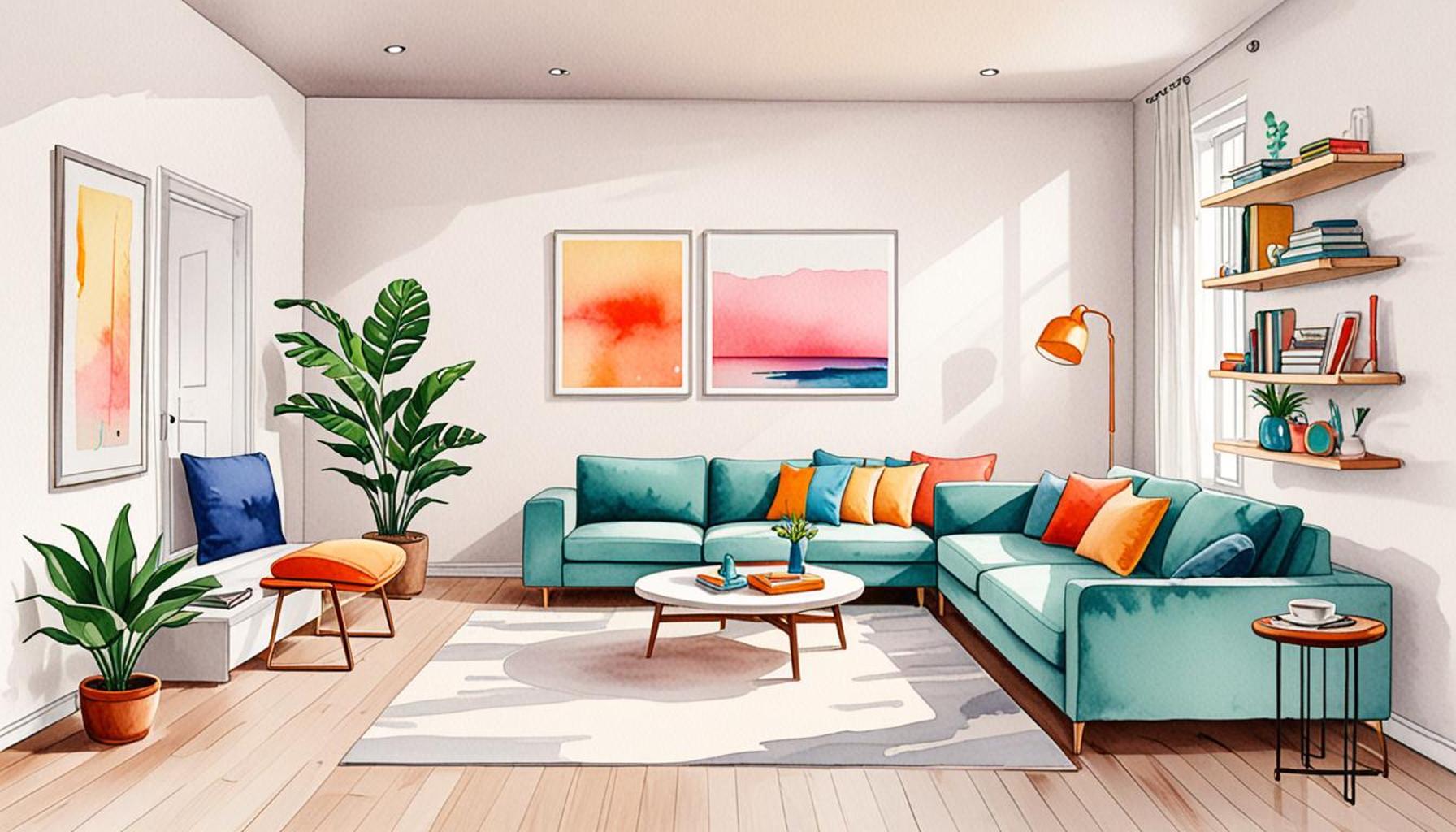Minimalist Living Rooms: Designing for Comfort and Space Efficiency

The Appeal of Minimalism in Modern Living
In today’s fast-paced world, the pursuit of a simpler lifestyle has gained traction among those seeking clarity and calm within their homes. The concept of minimalist living rooms serves not just as a design choice, but as a means of fostering a more intentional way of life. By prioritizing comfort and functionality while removing excess, individuals can create spaces that are both inviting and freeing.
A minimalist living room emphasizes essential elements, focusing on quality rather than quantity. This approach invites thoughtful selection of decor and furnishings. Notably, consider these key characteristics that define a minimalist aesthetic:
- Neutral Color Palettes: Soft, muted colors promote feelings of tranquility and spaciousness. Shades of white, beige, or soft grays can expand visual boundaries, making a room feel airier and more serene.
- Functional Furniture: Pieces that serve dual purposes are invaluable in minimalist spaces. For instance, a stylish coffee table can double as a storage space, while a convertible sofa bed offers both seating and sleeping options.
- Strategic Layout: Open spaces not only encourage flow but also help in creating a more breathable environment. Arranging furniture to facilitate conversation and movement can enhance social interactions while avoiding cramped areas.
The advantages of adopting a minimalist design extend far beyond aesthetics. Minimalism can lead to profound lifestyle changes, including:
- Reduced Stress: By cultivating a clutter-free environment, individuals often find their mental health improves significantly. Fewer distractions allow for greater focus and relaxation, creating a personal retreat from daily chaos.
- Increased Space: Embracing simplicity often leads to efficient layouts that make even smaller living areas feel more expansive. By optimizing the arrangement of furniture, homeowners can create the illusion of a larger space.
- Cohesive Aesthetic: A unified look fosters a sense of harmony and order. Every piece has its place and purpose, allowing for a seamless visual flow throughout the room.
Moreover, in the context of the United States, adopting a minimalist living space can lead to more sustainable practices. Opting for fewer, high-quality items often means investing in products that are environmentally friendly and long-lasting. This conscious choice supports eco-friendly brands and reduces waste, aligning personal values with broader environmental goals.
Ultimately, exploring minimalist living rooms offers a pathway to not just transform a physical space, but to encourage a deeper reflection on personal values and priorities. By embracing simplicity, you might find that it cultivates a haven of comfort and efficiency—one that enhances your well-being and resonates with larger societal changes.
DISCOVER MORE: Click here to find out how to create your calming space</a
Key Elements of Minimalist Living Room Design
When it comes to creating a minimalist living room, understanding the fundamental components is essential. Each aspect contributes to a harmonious atmosphere that promotes both comfort and efficiency, allowing residents to fully enjoy their living space. Let’s delve deeper into these key elements that can help transform your home into a tranquil retreat.
1. Decluttering: The Foundation of Minimalism
Before embracing a minimalist approach, the first step is to declutter. This involves purging items that no longer serve a purpose or bring joy. The process can seem daunting, yet it yields significant rewards:
- Emotional Release: Letting go of excess belongings can free up emotional space. Studies show that clutter can lead to feelings of overwhelm, while simplicity fosters peace.
- Enhanced Focus: A clean environment encourages clearer thinking, allowing you to concentrate on activities you truly enjoy.
- Increased Functionality: With fewer distractions, your living room can serve better its intended purposes, whether for relaxation, socializing, or entertaining.
2. Thoughtful Furniture Selection
In a minimalist living room, choosing the right furniture is critical. Opt for pieces that not only combine style with utility but also make a statement without overwhelming the space. Key considerations include:
- Multi-Functional Designs: Consider furniture that can serve multiple roles. For example, an ottoman can offer seating, storage, or act as a coffee table, effectively maximizing space.
- Quality Over Quantity: Investing in well-made items that last longer can reduce the need for frequent replacements—an essential principle of minimalism.
- Distinctive Statements: A single striking piece, such as an artistic lamp or a modern sofa, can serve as a focal point, drawing the eye and instilling personality without cluttering the space.
3. Emphasis on Natural Light
Natural light plays an important role in designing a minimalist living room. It enhances the airy and open feel of a space, making it feel larger and more inviting. To maximize natural light:
- Large Windows: If possible, opt for oversized windows or glass doors that allow sunlight to flood the room.
- Simplified Window Treatments: Choose sheer curtains or none at all to avoid blocking light and maintain an unobstructed view of the outdoors.
- Mirrors: Strategically placing mirrors can reflect light, making the room feel brighter and more spacious.
Incorporating these elements into your living room design will not only adhere to the minimalist concept but also enhance your day-to-day living experience. The goal is to create a space that resonates with your personal taste while embodying functionality and comfort. By choosing quality, maintaining simplicity, and allowing natural light to shine through, you create an environment that rejuvenates the mind and soul, cultivating a lifestyle of ease and refinement.
As we delve deeper into the realm of Minimalist Living Rooms, it’s essential to understand that achieving comfort and space efficiency is not just about decluttering. It involves strategic choices in design elements that harmonize with your lifestyle. The choice of color palettes, furniture arrangement, and even the type of décor plays a crucial role in creating an inviting atmosphere.
In minimalist design, the color scheme typically involves neutral tones such as whites, grays, and beiges. These hues create a calming environment and make the room feel larger and more open. Incorporating natural light through large windows or strategically placed mirrors can further enhance the ambiance, making a minimalist living room feel airy and spacious.
Another aspect worth considering is multifunctionality. In minimalist living rooms, furniture that serves multiple purposes is invaluable. For instance, a sofa bed can be an excellent choice for small spaces, providing comfort for everyday use while also accommodating guests when necessary. Additionally, built-in storage solutions can help maintain that much-desired clutter-free aesthetic while maximizing on floor space.
Designers often advocate for fewer, but more impactful, pieces of furniture. By selecting high-quality items with a strong visual presence, a minimalist living room can remain stylish without overwhelming the senses. Accessories should be chosen carefully; one or two well-placed decorative elements can serve as focal points without diverging from the minimalist ethos.
Emphasizing the concept of mindful consumption, a minimalist approach encourages individuals to invest in pieces that reflect their personal style rather than merely following trends. This thoughtful curation not only contributes to aesthetic value but also to overall well-being, fostering a peaceful nook conducive to relaxation.
| Category | Advantages |
|---|---|
| Space Utilization | Maximizes usable space through strategic furniture selection and placement. |
| Aesthetic Simplicity | Creates a serene environment that promotes relaxation and reduces stress. |
Ultimately, designing a minimalist living room is about more than just aesthetics; it’s a lifestyle choice that champions functionality and emotional well-being. The principles of minimalism encourage us to reflect on what we truly value in our homes, leading to spaces that are both beautiful and practical. Embracing this design philosophy can transform any living room into a sanctuary of comfort and efficiency.
EXPLORE MORE: Click here to learn about how technology enhances minimalist living
Strategic Color Choices and Textures
The palette of a minimalist living room plays a crucial role in defining the atmosphere. A well-thought-out color scheme can evoke feelings of calm while enhancing space efficiency. Here are some guidelines for selecting colors and textures:
1. Neutral Tones
Neutral colors, such as whites, beiges, and grays, create a sense of tranquility and provide a versatile backdrop. These hues reflect light, making rooms appear larger and more open. For instance:
- Bright Whites: Crisp, bright whites can amplify natural light, creating an airy ambiance that feels expansive.
- Soft Beiges: Beige offers warmth without overwhelming the senses, making it an excellent choice for creating a cozy feel.
- Cool Grays: Grays introduce a modern touch and can be paired with bold accessories for added interest.
While establishing a neutral base is essential, introducing accent colors through decor or furniture can add personality. A single sofa in a muted sage green or a couple of vibrant pillows can serve to enliven an otherwise neutral space.
2. Textural Variety
In a minimalist setting, texture becomes an element of intrigue. Mixing textures not only elevates the visual interest but also ensures a tactile experience, promoting comfort:
- Natural Materials: Incorporate wood, stone, or woven fabrics to connect your living space with nature, resulting in a calming atmosphere.
- Soft Fabrics: Use textiles such as velvets or boucles for cushions and throws to introduce warmth and comfort against the minimalist backdrop.
- Contrasting Finishes: Combining matte and glossy surfaces can create a dynamic interplay, enticing the eye to explore the space.
The Importance of Open Spaces
An essential aspect of minimalist design is the concept of open spaces. By minimizing obstacles, you allow for an unencumbered flow of movement, which promotes a serene living environment. Here are effective strategies to achieve openness:
1. Strategic Layout
When arranging furniture, consider the function of each piece in relation to the overall space. Position larger items like sofas against walls to create clear pathways. Also, consider:
- Clearing Sightlines: Avoid blocking views by maintaining sightlines through the room, guiding the eye and encouraging an open feel.
- Floating Furniture: Sometimes, floating furniture arrangements—like a coffee table centered within seating—can offer a balance between intimacy and spaciousness.
- Flexible Arrangements: Opt for movable or modular furniture that can be easily rearranged to suit different occasions, enhancing the functionality of the space.
2. Incorporating Greenery
Adding plants not only elevates aesthetic appeal but also enhances the feeling of openness and vibrancy. Consider the following:
- Potted Plants: Incorporate a few low-maintenance plants, such as snake plants or pothos, to promote air quality and a touch of nature.
- Vertical Gardens: For those with limited floor space, vertical gardens can bring life without sacrificing square footage.
- Nature-Inspired Decor: Use nature-themed art or decor to enhance the connection with the outdoors, creating a peaceful and inviting atmosphere.
By carefully considering color, texture, open layouts, and greenery, you can skillfully design a minimalist living room that embraces comfort while maximizing space efficiency. These elements not only construct an aesthetically pleasing environment but also contribute to a functional area that nurtures relaxation and social interaction.
DISCOVER MORE: Click here to learn how digital tools can simplify your life
Conclusion
In the realm of interior design, minimalist living rooms bring forth a harmonious blend of functionality and aesthetics. By stripping away unnecessary clutter and focusing on essential elements, homeowners can create spaces that are not only visually appealing but also deeply comforting. The thoughtful use of neutral color palettes coupled with varying textures can transform a simple room into an inviting sanctuary. Moreover, the strategic arrangement of furniture fosters an open layout, promoting movement and interaction.
Moreover, incorporating greenery amplifies the living environment, establishing a lively connection with nature that enhances overall well-being. These principles of space efficiency ensure that every square foot serves a purpose, allowing for a seamless flow that is essential in today’s fast-paced world. As you embark on the journey to design your minimalist living room, consider selecting versatile pieces that not only meet your aesthetic desires but also align with your functional needs.
Ultimately, minimalist design encourages us to appreciate simplicity while cherishing the values of comfort and well-being. As you embrace this lifestyle choice, you may find that less truly is more, leading to a calm and organized haven that reflects your unique personality. Dive deeper into strategies of minimalism and see how transforming your living space can lead to a more enriching and peaceful home life.



